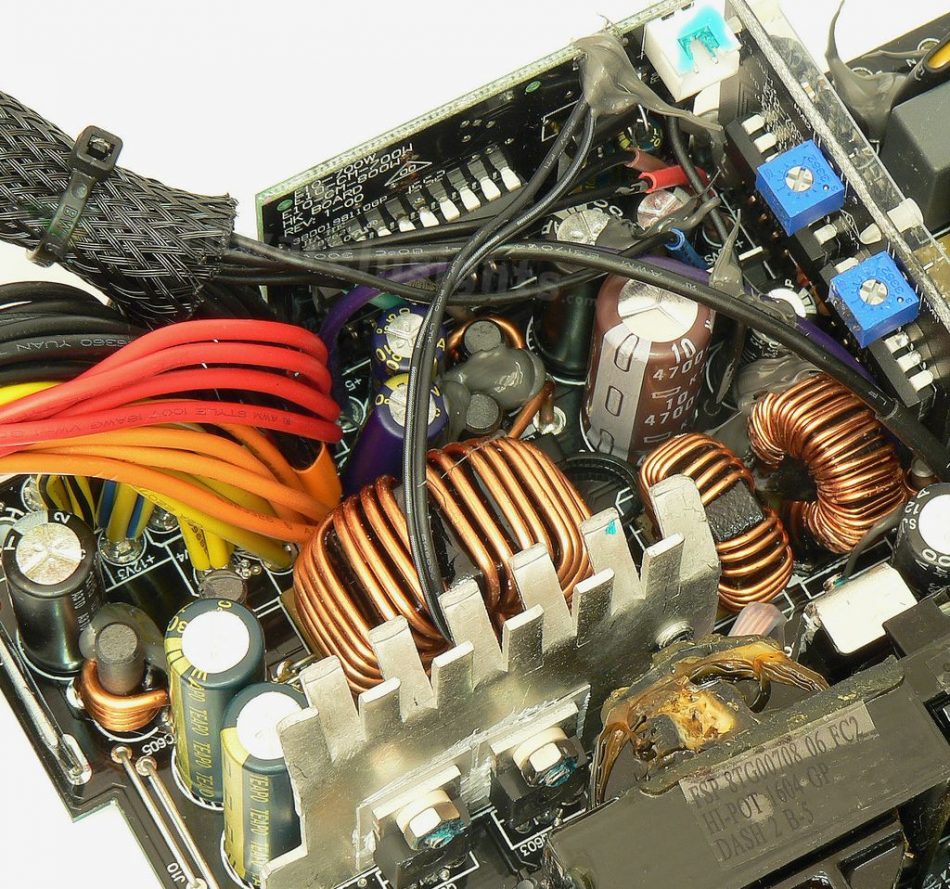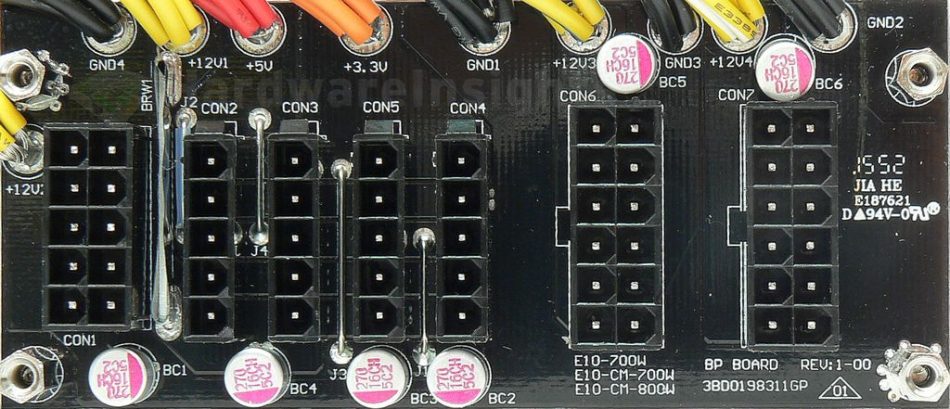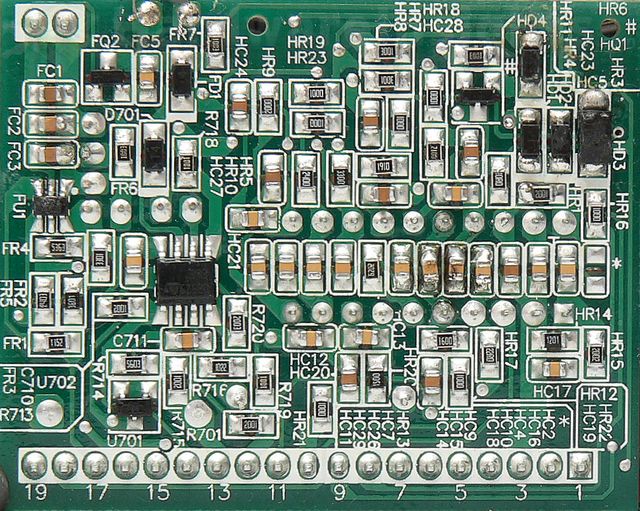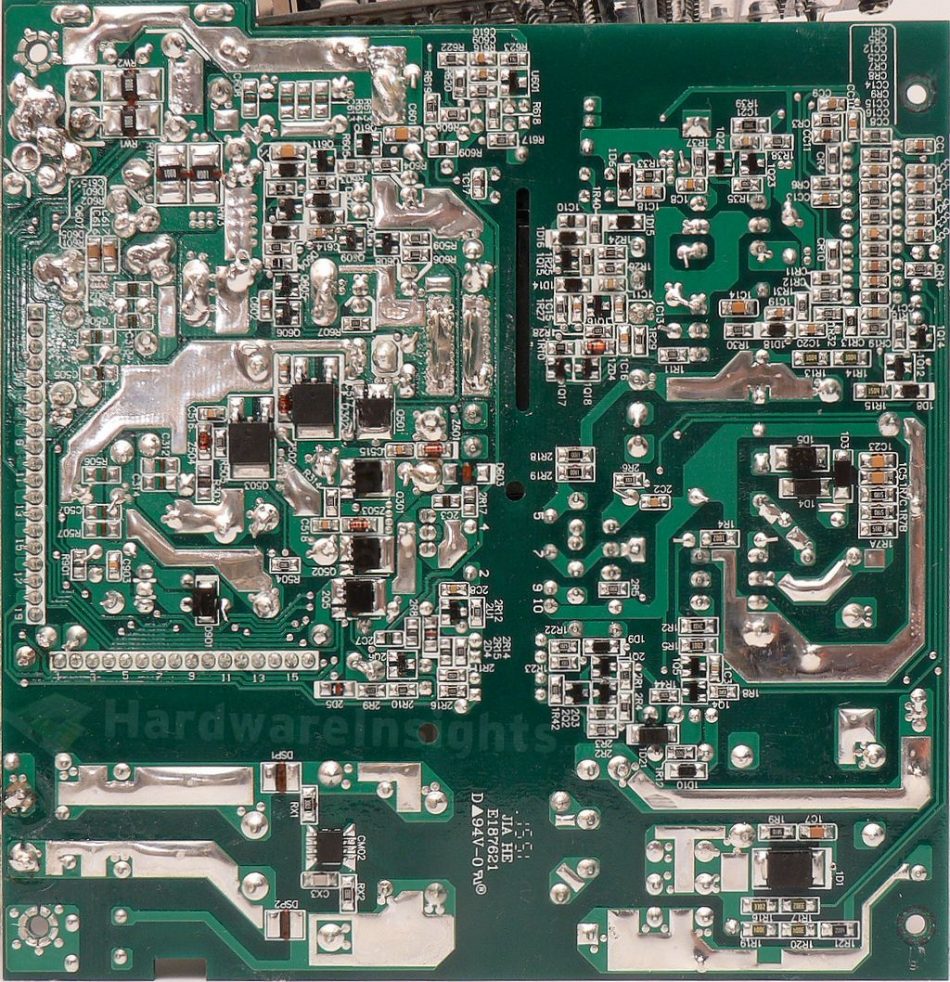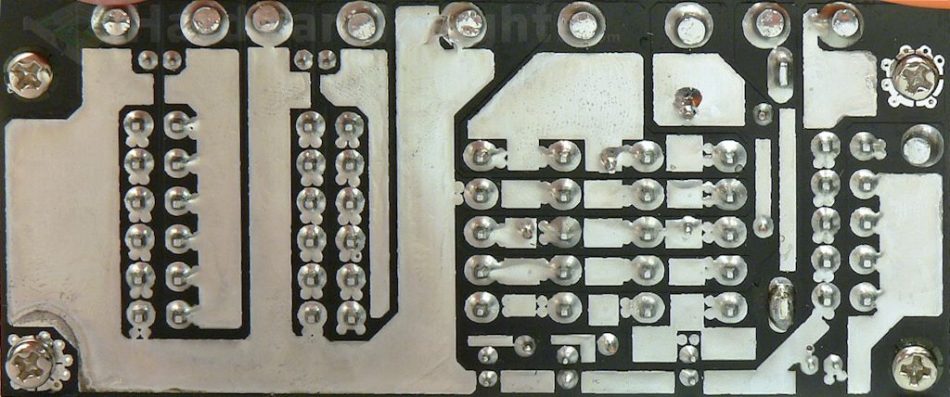Contents
- 1Introducing the Be Quiet! Straight Power 10 700 W CM (E10-CM-700W)
- 1.1Packaging and accessories
- 2Connectors & cabling
- 2.1Casing & cooling
- 3Input filtering
- 4Primary side
- 4.1+5 V stand-by rail
- 5Secondary side
- 5.1Build quality
- 6Load testing
- 6.1Loading +5 V SB
- 6.2Hold-up time
- 6.3Combined loading
- 6.4Combined loading ripple
- 6.5Crossloading, overloading
- 6.6Crossloading, overloading ripple
- 6.7Fan speed, temperatures and noise
- 7Conclusion and evaluation
- 7.1Thanks
- 7.2Discussion
Secondary side
The secondary side of the E10-CM-700W is the most interesting part. Those who expected DC-DC modules here are mistaken as those are only in the 500W and 600W version of this series. But I was very interested to see how Be Quiet! managed to re-design the whole thing with the expectation for reasonable voltage regulation, and that’s also why I wanted to check this platform out in the first place. Compared to its Aurum predecessors, it still carries multiple windings on the main transformer and all of them are still synchronously rectified. But this this time there are just two completely independent secondary windigs. One for the +12 V, the other is common for both the +5 and +3.3 V rails. Both have independent regulation. A few years back before I first had the Aurum platform in my hands, I initially thought that it’s already designed like this. Because what would be the point of a synchronously, yet also group-rectified platform? And therein lies exactly what you’re probably thinking: there is no reason for such a design, and that’s mostly why the Aurum sucks. But controlling how much power you draw from multiple transformer windings via transistors is not as easy as it sounds. You have to carefully tweak the design so that it does not saturate, and that’s most likely why FSP made the original Aurum platform as it was. But then Be Quiet! went ahead and worked through that.
But that was actually done already as far back as in 2014, so I wonder why the Pure Power L9 was not based on this design when it was released since it was already available at the time. Most likely it could not be manufactured cheaply enough to fit into its intended price envelope. So they used the Raider instead and it sucked much in the same way as the Aurum did. But back to the E10-CM-700W: The way they finally successfully implemented it was by using two FSP “6601” secondary side controllers which when combined together can drive three rails. They are located on a daughterboard on the left side with potentiometers for fine tuning. The +12 V rectification transistors are as usually located on a small secondary heatsink, which also acts as a conductor for the return path. They are four Infineon IPP034NE7N3 G (100/400 A at 25 °C and 75 V, RDS(On) 3.4 mΩ at 100 A) in TO-220 package. If I praised the transistors in the Super Flower Leadex Platinum then I can surely throw a point in their favor here, as these babies can move 30 kW of power. Each. Well, because of the power dissipation limitation it would be only about 15 kW but I still think it’s rather nice.
Both the +3.3 and +5 V rails each use two SMD transistors soldered to the bottom side of the board. One is an NXP PSMN2R6-40YS (100/651 A at 25 °C and 40 V, RDS(On) 2.8 mΩ at 25 A and 25 °C, 5.3 mΩ at 175 °C) in an LFPAK package. The other is an Infineon IPD036N04L (90/400 A at 25 °C and 40 V, RDS(On) 4.9 mΩ at 90 A and VGS of 4.5 V, 3.6 mΩ at 10 V) in a TO-252 package. The filtering for the +12 V consists of two custom D10×40 mm Teapo SC 3300/16 and one SJ 2200/16 cap. The +3.3 V has a Chemi-Con KZH 4700/10 (which is about the only quality cap around here) and an SZ 1500/10. The +5 V has an SJ 3300/10 and also an SZ 1500/10. The -12 V rail uses the ordinary L7912CV linear regulator with more Teapo (470/25 and 1000/16). There are also some Teapo CH 270/16 polymers on the modular board for each of the +12 V rails and also for the +3.3/+5 V. Groups of four 18AWG wires are used to connect the modular board to the main board. This solution was chosen because there also exists a non-modular version of this platform where the cables are soldered directly to the main board, but otherwise the platform is the same.
There are indeed four indepdenent +12V rails. They are monitored by the Weltrend WT7579 which has more OCP input channels thanks to a bigger DIP-20 package. It also monitors the usual stuff including OVP, UVP, PWR On and provides a PWR Good signal. It is located on another daughterboard. There is also a fan controller with a dual LM393 comparator. It uses a thermistor probe mounted directly to the secondary heatsink with a screw.
Build quality
As usual, I’ll focus on the overall build quality and other things like electrical safety here, as the quality of the components that were used has already been discussed before. The separation between the primary and secondary sides is good and there is also a slot milled out underneath the main transformer which aids in cooling. Both the varistor and thermistor are sleeved with heatshrink. Actually, most of the components have some extra insulation either using tape or heatshrink. The coils also have insulating boards beneath them. I like this. For an FSP Group product, the amount of silicone (grey) they used this time is quite reasonable.
Many of the tracks are reinforced with layers of solder, and for some of them they also added wires. A quality double-sided glass epoxy PCB is used. The soldering is nearly perfect, only the +3.3/+5 V Pi coils could have been soldered better, but that’s only mostly cosmetic. However, there is once again a sticky film of some sort present on the board once again. It’s either solderigng flux residue or some bad solder mask which didn’t cure properly. I only found seven tiny solder balls and four small ones. All of them were stuck firmly in the sticky film but that doesn’t guarantee that they wouldn’t come lose when the unit gets hot and the film more malleable. The trimming of the leads is not the best but at least the long ones are bent off to the side.
I can’t see any problem at all with the modular board though, so overall the result is -2 points here.
